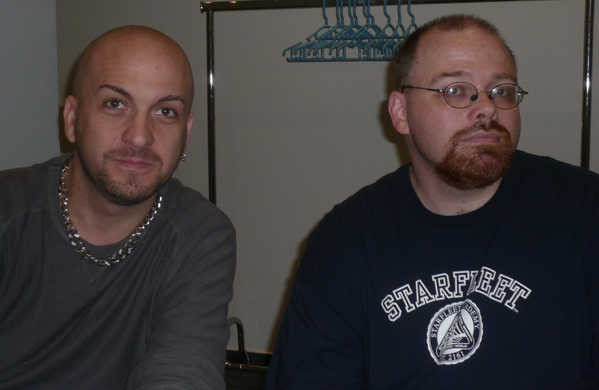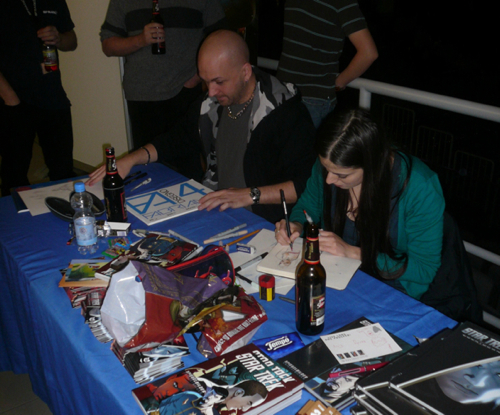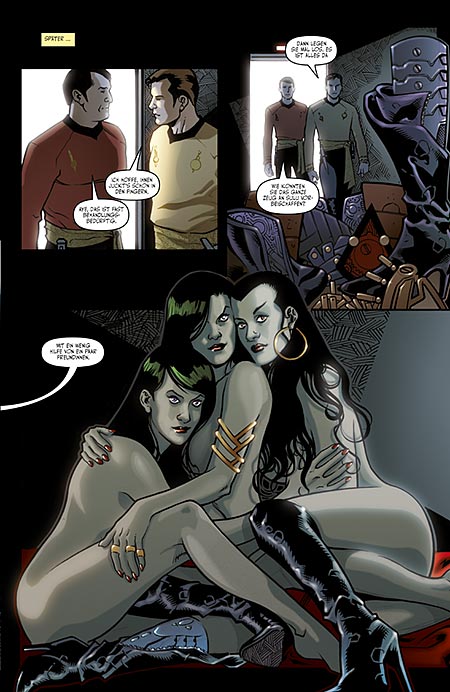US writer Scott Tipton is known for several Star Trek, Angel and Spike comic books as well as for his website comics101.com, where he publishes comments on the history of American comics. His frequent collaborator, the Italian David Messina, is a fan favorite Star Trek artist. Together they worked on comics like Star Trek: Mirror Images [Spiegelbilder] und Star Trek – The Next Generation: Intelligence Gathering [Tor zur Apokalypse], published in Germany by Crosscult. David Messina is also the artist of Countdown, the official prequel of the new Star Trek movie.
Andreas Völlinger interviewed the two comic book artists in November at the Fantasydays in Düsseldorf while a wild cosplay show took place in the hall right below the press room.
[Hier geht’s zur deutschen Version.]

Comicgate: Alright, I’m here with Scott Tipton [right on photo] and David Messina [left on photo]. Scott, you are from the United States, but which part exactly?
Scott Tipton: From Los Angeles.
CG: And David, where in Italy do you live?
David Messina: Rome.
CG: How was the convention so far for you guys?
ST: It’s been interesting. It’s very unlike any convention in the US.
CG: What is different?
ST: I can’t say this one is like all the German conventions because it’s the only one I’ve ever been to. But this one is so much focused on fantasy and cosplay. They have this giant stage and the musical acts. It’s very unique.
CG: We also do have more traditional comic book conventions, which focus more on comics and are probably closer to what you have in the US, like–
ST: Like San Diego [Comic Con] or the Wonder Con?
 CG: Exactly. And David, what about the Italian comic book conventions?
CG: Exactly. And David, what about the Italian comic book conventions?
DM: The Italian conventions are mostly smaller, except for Lucca Comics Festival which is big. And there aren’t so many cosplayers around. I have been to a lot of conventions here in Germany but mostly Star Trek conventions like FedCon in Bonn. And that was different, with the all the actors being there and so on. This one is more like a party.
ST: Two different things that I noticed about German conventions: Extremely attractive female Trekkies. And beer served at the signing table. Both of which are an advantage over the US. (laughs)
CG: The two of you are mainly here because you do Star Trek comic books for IDW, which are published here in Germany by Cross Cult. Are both of you Star Trek fans?
ST: I’ve been one my whole life.
CG: You are a real Trekkie?
ST: Oh yeah, absolutely.
DM: I’m not that big of a fan. I watched the TV show with my sister, when I was a child, the original one with Spock and Kirk. Although I did enjoy the evolution of Star Trek and watched a number of episodes of the following Star Trek series when I started working with Scott, my love is with the old Enterprise crew. I watched the old episodes repeatedly. And I’m a fan of J.J. Abrams‘ new batch of Star Trek. I just love the old crew with Uhura and Kirk.
CG: So you must have really enjoyed doing Star Trek: Mirror Images because you had to draw all the old characters.
DM: Yes, that one has all the classic characters I really love. But I also have a soft spot for [Deep Space Nine’s] Sisko and [The Next Generation’s] Picard. Scott thinks it’s because we have the same hair style. (laughs)
 CG: When you did Star Trek: Countdown, the prequel to the new movie, there was probably a lot of pressure on you because of all the hype the film was surrounded by.
CG: When you did Star Trek: Countdown, the prequel to the new movie, there was probably a lot of pressure on you because of all the hype the film was surrounded by.
ST: There was no pressure on me because I wasn’t allowed to write it. (laughs)
DM: It was written by Tim Jones and Mike Johnson.
CG: Were they on the film’s production team?
DM: Yes, they work for Robert Orci and Alex Kurtzman, who wrote the script for the new Star Trek movie. The script for Countdown was based on a plot by Orci and Kurtzman. Working on it was a lot of pressure for me because everything was absolutely secret when I started. I saw the movie three months after I had done the last issue. It wasn’t a problem to draw the good guys in Countdown because they were characters from Star Trek: The Next Generation plus Spock, but the bad guy, Nero, was a new character from the movie. So I didn’t know how the actor [Eric Bana] would appear in the movie and how his ship, the Narada, was shown. I had some pictures of the Narada and some stuff about the environment, but I never saw how the ship appeared on screen. When I saw the movie the first time I was surprised because I had never imagined that the Narada would seem so alive.
CG: But are you nevertheless satisfied with the finished comic book? From what I’ve read so far the fans‘ reactions were pretty positive.
ST: The reactions have been great. It was the first time in years I got to enjoy David’s work strictly as a reader. I thought it was great, and the writers did a great job with it. Sales in the US were really good, and the readers’ reactions were almost unanimously positive.
 CG: The two of you collaborated on Star Trek: Mirror Images and there is another book that is supposed to come out in Germany soon: Intelligence Gathering [German release in December 2009 as Tor zur Apokalypse].
CG: The two of you collaborated on Star Trek: Mirror Images and there is another book that is supposed to come out in Germany soon: Intelligence Gathering [German release in December 2009 as Tor zur Apokalypse].
ST: Intelligence Gathering – that’s a Next Generation series. We’ve also done a Klingon series, Blood Will Tell, and that is also slated for a German release. And we did Spock: Reflections, which is kind of a pre-prequel to the movie. There we find out what Spock has been doing between the last movies with the old crew and Countdown.
CG: How much freedom do you have when writing stories for Star Trek comics?
ST: Pretty much. Overall, they are pretty good to me. I have to make a first pitch about what I want to do, and once it got approved they pretty much trust me.
CG: I imagined there must be strict rules if you wrote for a franchise like Star Trek.
ST: It’s strict, but not if you are doing it as long as we do [Scott’s brother David acts a as co-writer on the Star Trek comics]. We crossed every team, we researched everything … Once we make our pitch to CBS everything is good to go.
CG: David, is it pretty difficult for you as an artist to mostly draw characters who are based on real humans, on actors?
DM: Sometimes it’s really hard. Some actors like Leonard Nimoy as Spock are very particular and characteristic but others like William Shatner as Kirk or David Boreanaz from Angel aren’t so much. They are pretty hard to draw. I work more easily with iconic characters like Spock or Spike [James Marsters] from Angel. It’s real fun to draw Spock because his face is an icon – a SciFi icon. I really like to draw it, and it’s almost relaxing for me.
 CG: Are fans very concerned about the look of the characters in the comic books? I mean, it is often said about Star Trek fans that they are a very critical bunch.
CG: Are fans very concerned about the look of the characters in the comic books? I mean, it is often said about Star Trek fans that they are a very critical bunch.
ST: The thing about the Trekkies is: If you get something wrong, they will let you know. But overall, the response from the Trek fans has been very good on everything we have done. And that’s great to hear for us. Those people pay our bills, and we wouldn’t talk bad about them. They have been very supportive. But if you got a color wrong or you got a uniform wrong, you get an email. (laughs) But that’s good, it keeps us honest. You don’t want us cheap.
CG: You also collaborated on Angel comic books …
ST: Yes, together we did one Angel mini-series: „Auld Lang Syne“.
DM: And an adaptation of „Smile Time“.
ST: Oh yes, we also did a comic book adaptation of the „Smile Time“-TV episode.
CG: Since you are mainly working with existing characters in licensed series, do you prefer telling stories in a shared universe or do you sometimes miss the freedom to do whatever you want in your comics?
ST: It’s tricky because the American comics market is very much dominated by licensed characters. Whether it’s Marvel and DC or Star Trek. Getting your own new character to publishing is very difficult. David and I have a character of our own that we want to get published for several years now. We just didn’t have the opportunity. Every time we want to work on it, one of us gets two or three series to do. We will be doing it, but we didn’t have the time yet.
CG: But you still enjoy what you are doing now?
ST: Of course. Any day where I get to write Spike or David gets to draw Spock is a good day.
CG: And now to the traditional question … David, how did you become a comic book artist?
DM: I started drawing when I was a child and later I studied at the Scuola Internazionale di Comics [International School of Comics] in Rome, the same school where I now teach classes myself. My favorite artists have always been Adam Hughes and Mike Mignola. I buy everything they do. Really everything. Even if it’s only a cover done by one of them, I pick up the book. The other big influence came from manga. I really like the dynamic and cinematic style. I think that along with Adam Hughes and Mike Mignola Katsuhiro Otomo [Akira] is a big influence on my work. And there is also some influence from classic painting. Because of my father, who is a professional painter, I grew up in a house full of art. So, painters like Magritte or Klimt influenced my style too. Mostly the composition of the colors.
CG: That’s interesting …
DM: Yes, and it’s my father’s access to my work if I want to talk with him about it. Because for him everything I do as a comic book artist is so far away from what he does and knows. It’s really kind of funny.
CG: And Scott, you actually started out writing about comics, right?
ST: Well, I kind of got my start when Chris Ryall, who is now the publisher at IDW, and I were working for Kevin Smith. We were running one of his pop culture websites, moviepoopshoot.com. Chris was the editor in chief, I was the associate editor, and at that site I was writing Comics101, my weekly column on comic book history. I’ve done that for three years – never missed a day by the way. I’m still proud of that.
 CG: Is it still accessible?
CG: Is it still accessible?
ST: The site is gone. But the comics content is still available on my own site now, comics101.com. Well, after two or three years of doing moviepoopshoot.com, Chris got the attention of the folks at IDW, they had realized he was a great editor, and he began working for them. And once he got the job, he asked me if I was interested in writing comics. I told him that if he thinks the right project for me shows up I would love to talk about it. First, I did several short horror adaptations for a book called Doomed. And then they got the Angel license from Fox. And I love Angel! So I said ‚Look, just give me a chance. Let me pitch a story and if they like it – fantastic.‘ I pitched a Spike story, which Fox liked, and so they bought it. So, that was my first Spike story, Spike: Old Wounds, and since then I was doing Spike and Angel fairly regularly. And then they got the Star Trek license. I went like ‚Star Trek! License!! Dude!!!‘ Just open the doors, let me make a pitch!‘ Luckily, the people at CBS have been really receptive to my work.
CG: Are there any characters outside the ones you are working on now that you would really like to get your hands on?
ST: Blue Beetle and Yellow Jacket. Really! We would do our own Marvel/DC crossover with them. David would draw it, I would write it, just give us a chance. (laughs)
CG: You are also kind of a comic book historian. With your background knowledge, what would you say about the present state of the comic book industry? There is this big discussion in Germany as well as in the US about where it is heading. What about digital comics?
ST: Overall, the comic book industry is strong right now. I think the way of the future is to do more and more digital stuff. IDW has been doing some great stuff there and made comics available for the iPod. But eventually, printed comic books will never be going away. They will always be there because people want the haptic experience.
CG: Do you think that this will be more and more in form of graphic novels and trade paperbacks?
ST: Right. I think that the monthly comic book will be sold digitally only in the future. And those books will be collected into trades and hardcovers. That won’t happen next month or next year, but I’m convinced that is the road we are going.
CG: So you look into the future of comic books positively?
ST: Definitely. And there are still too many readers who want their comics every month. Sales are a bit depressed now because of the general economy, but that will change again.
CG: Nice closing words. Thanks for the interview, you two!
RELATED LINKS:
Comicgate review of Star Trek: Spiegelbilder (German)
Comicgate review of Star Trek: Countdown (German)
David Messina’s Blog
Scott Tipton’s Comics 101
Cross Cult (German publisher of Star Trek comics)
Preview of Star Trek: Tor zur Apokalypse on Treknews.de (German)
Photos © Andreas Völlinger/comicgate.de
